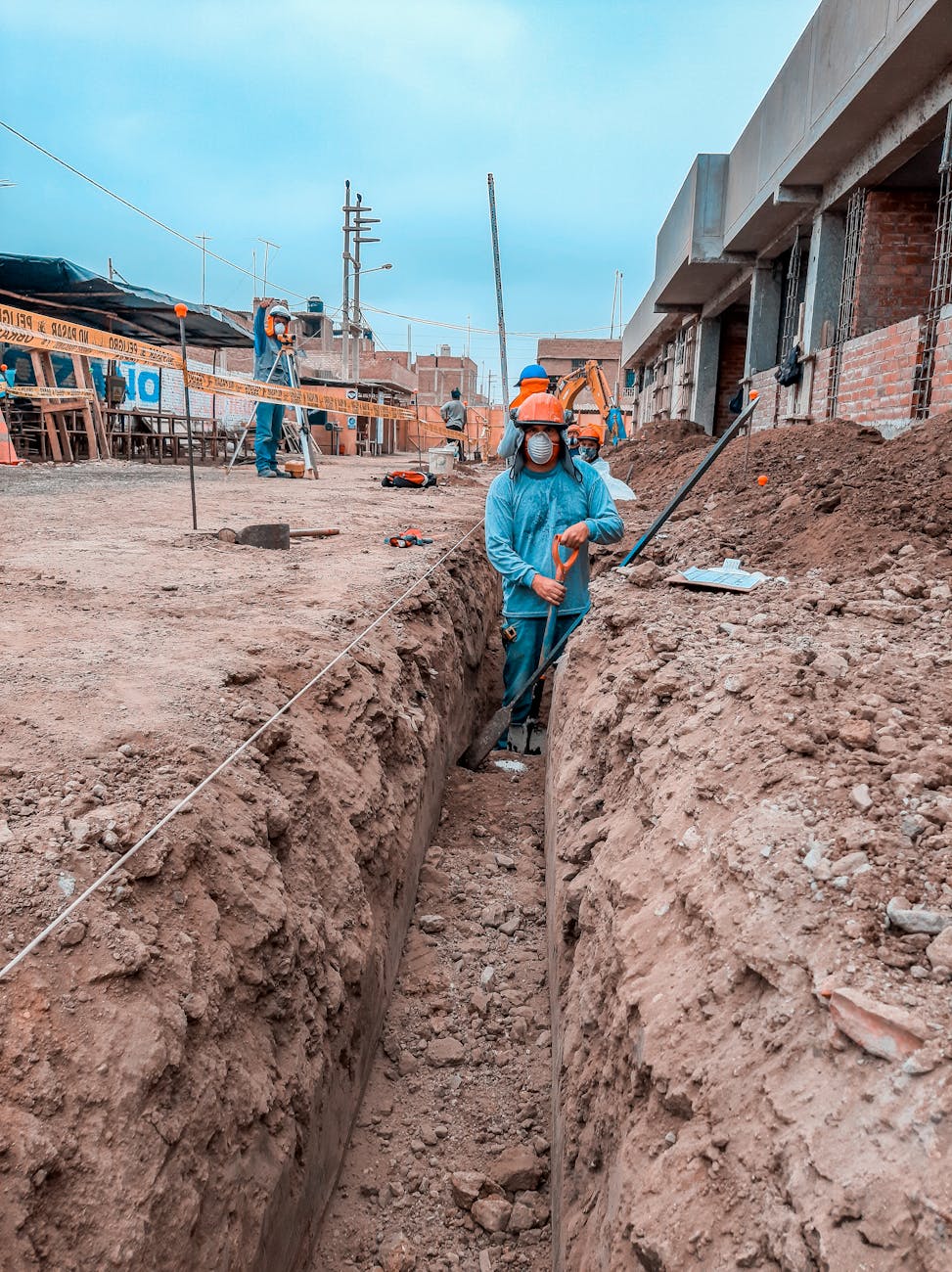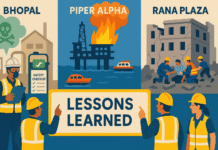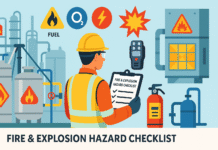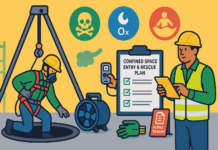
Excavation and Trenching Safety JSA – Job Safety Analysis
1. Introduction
Excavation and trenching work is one of the most hazardous construction activities. It involves removing soil, rock, or other materials to form a cavity in the ground. Workers are exposed to risks such as cave-ins, falls, hazardous atmospheres, falling loads, and equipment-related accidents.
According to OSHA, trench collapses are more likely to result in worker fatalities than any other excavation-related hazard.
A Job Safety Analysis (JSA) for excavation and trenching helps identify hazards in each step, assess risk levels, and apply effective control measures to ensure worker safety.
2. Purpose of This JSA
The main objectives are:
- To systematically identify hazards in excavation and trenching operations.
- To outline preventive and protective measures before starting work.
- To ensure compliance with legal and industry safety standards.
- To reduce the risk of injury, equipment damage, and project delays.
3. Applicable Standards & Regulations
- OSHA 29 CFR 1926 Subpart P – Excavations
- BS 6031: Code of Practice for Earthworks
- IS 3764: Indian Standard – Safety Code for Excavation Work
- ISO 45001 – Occupational Health and Safety Management Systems
- Company-specific excavation safety procedure
4. Scope of Work
This JSA applies to all activities involving:
- Trench digging for utilities (water, sewer, electrical, telecom)
- Basement and foundation excavation
- Roadwork excavation and trenching
- Pipeline and cable trenching
- Earth removal for landscaping or grading
5. Step-by-Step JSA Process for Excavation & Trenching
Step 1: Job Breakdown
- Pre-job planning and site survey
- Locating and marking underground utilities
- Mobilizing equipment and materials
- Setting up traffic and pedestrian control (if applicable)
- Excavating to planned dimensions
- Installing protective systems (sloping, benching, shoring, shielding)
- Monitoring trench conditions during work
- Entry and work inside the excavation
- Backfilling and compaction
- Site clean-up and demobilization
Step 2: Hazard Identification
Key hazards include:
- Cave-ins due to unstable soil or inadequate protective systems
- Falls into the trench by workers or equipment
- Falling loads from equipment operating near the edge
- Hazardous atmospheres (oxygen deficiency, toxic gases)
- Contact with underground utilities (gas, electrical, water)
- Struck-by incidents from machinery or moving vehicles
- Flooding from rainwater or broken water lines
- Noise, vibration, and dust exposure
Step 3: Risk Assessment Table
| Task | Hazard | Potential Consequence | Risk Rating | Control Measures |
|---|---|---|---|---|
| Site survey | Unidentified underground utilities | Explosion, electrocution | High | Utility locator service, as-built drawings |
| Equipment mobilization | Struck-by machinery | Serious injury/death | High | Spotter, exclusion zone |
| Excavation | Cave-in | Fatality | High | Protective systems, soil classification |
| Working in trench | Hazardous atmosphere | Suffocation, poisoning | High | Atmospheric testing, ventilation |
| Edge work | Falls into trench | Broken bones, head injury | Medium | Barricades, signage |
| Backfilling | Struck-by equipment | Serious injury | Medium | Spotter, communication signals |
6. Control Measures
A. Engineering Controls
- Protective systems:
- Sloping: Cutting trench walls back at an angle to prevent collapse.
- Benching: Stepped sides to reduce soil pressure.
- Shoring: Support structures like hydraulic shores to hold trench walls.
- Shielding: Trench boxes to protect workers from cave-ins.
- Install barriers, guardrails, and trench covers.
- Use water pumps to prevent flooding.
B. Administrative Controls
- Competent person must inspect the excavation daily and after any hazard-increasing event (rain, vibration, etc.).
- Establish a permit-to-work system for excavation.
- Prohibit equipment from operating too close to the edge without proper support.
- Assign a dedicated signaler for heavy equipment.
- Conduct Toolbox Talks before starting each shift.
C. Personal Protective Equipment (PPE)
- Hard hat
- High-visibility vest
- Steel-toed boots
- Cut-resistant gloves
- Safety glasses or goggles
- Respiratory protection (if required)
- Fall protection harness (if near edge without guardrails)
7. Roles & Responsibilities
- Site Manager: Approves work plan, ensures competent personnel are available.
- Competent Person: Classifies soil, selects protective system, inspects excavation.
- Excavator Operator: Follows safe digging procedures.
- Labor Crew: Works inside trench only when protective systems are in place.
- Safety Officer: Conducts hazard monitoring and compliance checks.
8. Emergency Preparedness
- Rescue Plan: Pre-plan rescue procedures in case of collapse or worker injury.
- First Aid: Trained first aiders and kits available onsite.
- Emergency Numbers: Posted at site entrance and work area.
- Atmospheric Monitoring: Continuous if hazardous gases suspected.
- Evacuation Route: Clear and unobstructed path for workers.
9. Best Practices for Excavation Safety
- Keep spoil piles at least 2 feet from the edge.
- Maintain safe access and egress (ladders every 25 feet in trenches 4 feet or deeper).
- Do not allow workers in trenches with water accumulation unless precautions are taken.
- Never work beneath raised loads.
- Avoid working in trenches deeper than 5 feet without protective systems (OSHA requirement).
- Provide proper lighting for night or low-visibility work.
10. Sample JSA Form – Excavation and Trenching
Job Title: Excavation & Trenching Safety
Location: ________________________
Date: ________________________
Supervisor: ________________________
| Task Step | Hazard | Control Measure | PPE Required | Responsible Person |
|---|---|---|---|---|
| Site survey | Hitting utilities | Utility mapping, locator service | Helmet, vest | Supervisor |
| Excavation | Cave-in | Shoring, sloping, shielding | Helmet, boots | Competent person |
| Working in trench | Hazardous atmosphere | Gas testing, ventilation | Respirator, helmet | Crew |
| Backfilling | Struck-by | Spotter, exclusion zone | Helmet, gloves | Operator |
| Cleanup | Slips, trips | Housekeeping | Boots | Crew |
11. Conclusion
A properly conducted Excavation and Trenching JSA is not just a legal requirement — it’s a life-saving practice. Every step of excavation work must be carefully planned, hazards identified, and controls implemented.
The safest excavation sites are those where every worker understands the risks and follows the plan without shortcuts.
✅ Final Safety Reminder:
“You can dig a trench again, but you can’t replace a life. Work safe, work smart, and go home alive.”
Scaffold Erection and Dismantling JSA – Job Safety Analysis
Manual Material Handling HIRA – Top 10 Ergonomic Hazards and the Ultimate Safety Blueprint
Electrical Work HIRA – Top 10 Critical Hazards and the Ultimate Safety Blueprint
Confined Space Entry HIRA – Top 10 Deadly Hazards and the Ultimate Safety Guide
Lifting and Rigging Operations HIRA – Top 10 Critical Hazards and the Ultimate Safety Guide

























good